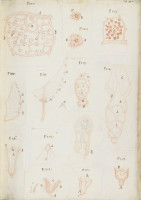Plant buds, leaves and flowers
Date
1675
Creator
Unknown, Engraver
After
Marcello Malpighi (1628 - 1694, Italian) , Biologist
Object type
Library reference
54269
Material
Dimensions
height (page): 362 mm
width (page): 231mm
height (plate): 310mm
width (plate): 217mm
width (page): 231mm
height (plate): 310mm
width (plate): 217mm
Subject
Description
Sectional studies of the buds, leaves and flowers of seven plant species viewed under magnification, including:
Figure 107 [upper left]: Poplar tree, Populus, chestnut tree, Castanea, and mulberry tree, Morus, referred to Malpighi as Popula, Castanea, and Moro respectively.
Figure 108 [upper centre]: Olive tree, Olea, referred to as the same.
Figure 109 [upper right]: Fig tree, Ficus carica, referred to as Ficus.
Figure 110 [centre left]: Medlar tree, Mespilus germanica, referred to as Mespilorum.
Figure 111 [centre left]: Cherry tree, Cerasum, referred to as Cerasi.
Figure 112 [lower left]: Poplar tree, Populus, and vine, Vitis, referred to as Populo and Vite.
Figure 113 [centre right]: Peach tree, Prunus persica, referred to as Malo armeniaca.
Figure 114 [centre right]: Prune tree, Prunus americana, and almond tree, Prunus amygdalus, referred to as the same.
Figure 115 [lower right]: Olive tree, Olea, and lemon tree, Citrus limon, referred to as Olea and Malo limonia.
Figure 116 [lower left]: Henbanes, Hyoscyamus, referred to as Hyoscyamo.
Fig. 117 [lower right]: Saffron, Crocus sativus, and pea, Pisum sativum, referred to as Collutea and Pisis respectively.
Fig. 118: Sage, Salvia officinalis, referred to as Sclarea.
Inscribed: ‘TAB.XXI’ in the top right-hand corner.
Table 21 from Marcello Malpighi's Anatome plantarum; cui subjungitur Appendix […] (1675).
Marcello Malpighi (1628-1694), Italian biologist and physician, was elected a Fellow of the Royal Society in 1669.
Figure 107 [upper left]: Poplar tree, Populus, chestnut tree, Castanea, and mulberry tree, Morus, referred to Malpighi as Popula, Castanea, and Moro respectively.
Figure 108 [upper centre]: Olive tree, Olea, referred to as the same.
Figure 109 [upper right]: Fig tree, Ficus carica, referred to as Ficus.
Figure 110 [centre left]: Medlar tree, Mespilus germanica, referred to as Mespilorum.
Figure 111 [centre left]: Cherry tree, Cerasum, referred to as Cerasi.
Figure 112 [lower left]: Poplar tree, Populus, and vine, Vitis, referred to as Populo and Vite.
Figure 113 [centre right]: Peach tree, Prunus persica, referred to as Malo armeniaca.
Figure 114 [centre right]: Prune tree, Prunus americana, and almond tree, Prunus amygdalus, referred to as the same.
Figure 115 [lower right]: Olive tree, Olea, and lemon tree, Citrus limon, referred to as Olea and Malo limonia.
Figure 116 [lower left]: Henbanes, Hyoscyamus, referred to as Hyoscyamo.
Fig. 117 [lower right]: Saffron, Crocus sativus, and pea, Pisum sativum, referred to as Collutea and Pisis respectively.
Fig. 118: Sage, Salvia officinalis, referred to as Sclarea.
Inscribed: ‘TAB.XXI’ in the top right-hand corner.
Table 21 from Marcello Malpighi's Anatome plantarum; cui subjungitur Appendix […] (1675).
Marcello Malpighi (1628-1694), Italian biologist and physician, was elected a Fellow of the Royal Society in 1669.
Object history
Anatome Plantarum was a much-anticipated work and, along with Nehemiah Grew FRS (1641-1712), earned Malpighi acclaim as founder of the microscopic study of plant anatomy.
His research was encouraged and supervised by the Royal Society, as evidenced by correspondence between him and the then-Secretary, Henry Oldenburg FRS (1619-1677) in the 1660s and 1670s [MS/103/1]. An abstracted version of his work in this area was first read at a Society meeting on 7 December 1671 [JBO/4, pp.216-217]. The full manuscript of Anatome Plantarum, together with the frontispiece artwork and these plates, was received and read on 28 January 1674/75 [MS/103/1-2].
It was ordered for printing by the Society’s printer John Martin in June 1675 [CMO/1/221]. The published work consists of the text of Anatome Plantarum, De ovo incubato, and 61 plates illustrating each [54 and 7 respectively]. A second part was sent by Malpighi to the Society in 1678 and published in 1679 as Anatomes plantarum pars altera [54271].
His research was encouraged and supervised by the Royal Society, as evidenced by correspondence between him and the then-Secretary, Henry Oldenburg FRS (1619-1677) in the 1660s and 1670s [MS/103/1]. An abstracted version of his work in this area was first read at a Society meeting on 7 December 1671 [JBO/4, pp.216-217]. The full manuscript of Anatome Plantarum, together with the frontispiece artwork and these plates, was received and read on 28 January 1674/75 [MS/103/1-2].
It was ordered for printing by the Society’s printer John Martin in June 1675 [CMO/1/221]. The published work consists of the text of Anatome Plantarum, De ovo incubato, and 61 plates illustrating each [54 and 7 respectively]. A second part was sent by Malpighi to the Society in 1678 and published in 1679 as Anatomes plantarum pars altera [54271].
Associated place
